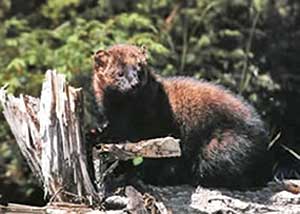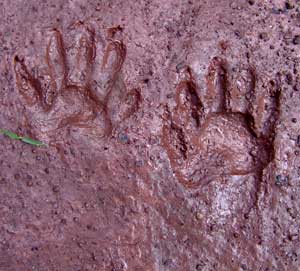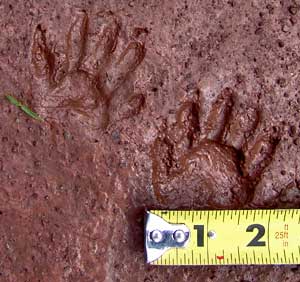Fishers were re-introduced to The Catskill Mountains in recent years. Back in the early 1900's, Fishers were trapped and hunted to extinction in the Catskill Mountains. Today there is a healthy population of them. They tend to be fairly elusive and rarely seen.
Fishers range in weight from 4-to-16 pounds. Female Fishers are about half the size of Male Fishers. Fishers range in length from 32-to-40 inches. Half of the length is the long bushy tail. Their body lengths are about 15-20 inches long. Fisher's fur color is dark brown to black. The fur is coarse. Fishers are very muscular. Their legs are short but stocky. They also have retractable nails, like a domestic cat. In spite of their short feet, they are very fast and agile. They have small round ears, and small eyes. Fishers live approximately 10 years in the wild. Fisher make a variety of sounds. They can be chuckles, growls, hissing, snarls, grunts, etc. They usually make noises during mating and while being aggressive.
Fishers usually walk and runs in hops. That is, both front legs come down together. The average stride of a walking Fisher is approximately 20-21 inches. A stride is the measurement from the front leg prints to the next front leg prints. This would be every other set of prints. You will have prints of front-to-back-to front. The distance from front-to-back leg prints is around 10 inches.
Fishers prefer conifer and mixed forest (conifer and deciduous) forest. But, they may use deciduous forest. When winter arrives, they move from higher elevation forest to lower-land forest. Usually conifer forest. They may also move to wet conifer swamps. Fishers can nest in a variety of locations. They can use tree cavities up to 30 feet off the ground. They may also nest in hollow logs, under rocks (caves), abandon beaver dams, etc. Fishers are good at walking, tree climbing, and swimming. Males Fishers have a territory of 4-10 square miles, where the female fishers have a 1-3 square miles.
Fishers are opportunistic hunters. They will search for the easist meals. They are also omnivores (plants and animals). Their primary diet is rabbits, voles, mice, and squirrels. But, they also eat seeds, nuts, and seeds. But, fishers can also eat porcupines. They grab the porcupines by the mouth and flip it over to expose the porcupine's belly. A porcupine can feed a Fisher for up to a month. A rabbit can feed Fishers up to a week.
Fishers are most active at dusk and dawn. They are usually active for a couple hours before sleeping again. Fishers will travel 1-2 miles per day looking for food. But, if they are searching for a mate, they can travel up to 20 miles a day. Fishers do not hibernate, and they are active all year.
Fishers have very few predators. One of the reasons why this smaller animal has few predators is because of it's aggressive behavior. It is also agile and fast. The most common predators are bears, coyotes, bobcats, and Great-Horned Owls (fishers up to 12 pounds). Some people like to classify them as miniature woverines.
They give birth to young between March and April. They have 1-6 young fishers. They average 2-3 per year. Oddly, Fisher mate 10 days after giving birth. They will remain pregnant until March/April of the following year. The fertilized eggs will not implant until 30 days before giving birth. After 50 days, the young will open their eyes. After 4 months, they will be weaned. The young will disperse in late Fall or early Winter.
|
 |
 |
 |
Fisher |
 |
 |
 |
Fisher Tracks |
 |
 |
 |
Fisher Tracks |
 |
 |
 |
Fisher Tracks
Stride is around 20-21 inches (top prints to bottom
prints in picture - skip middle prints) |
|

